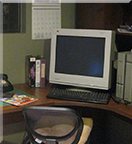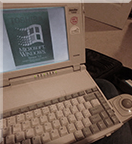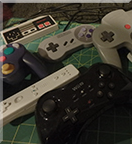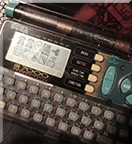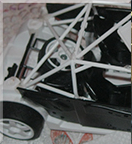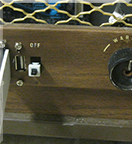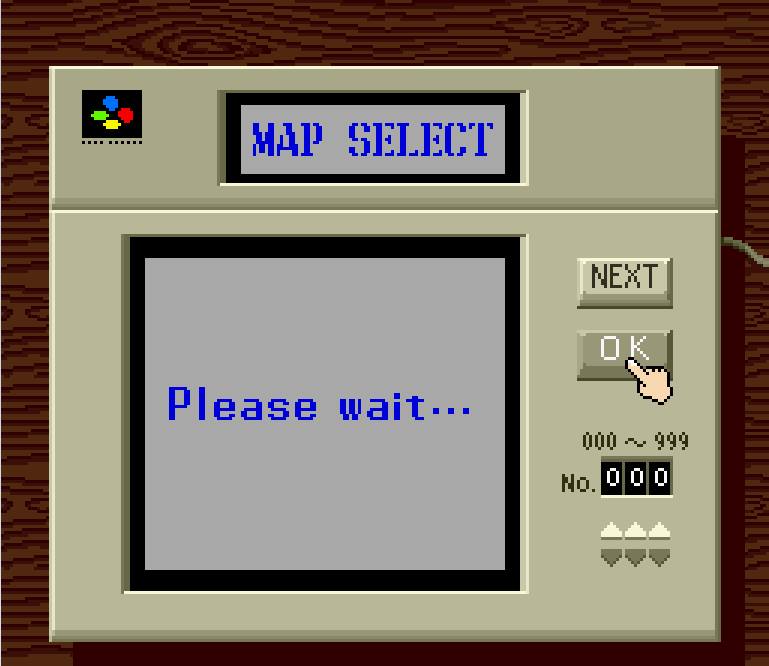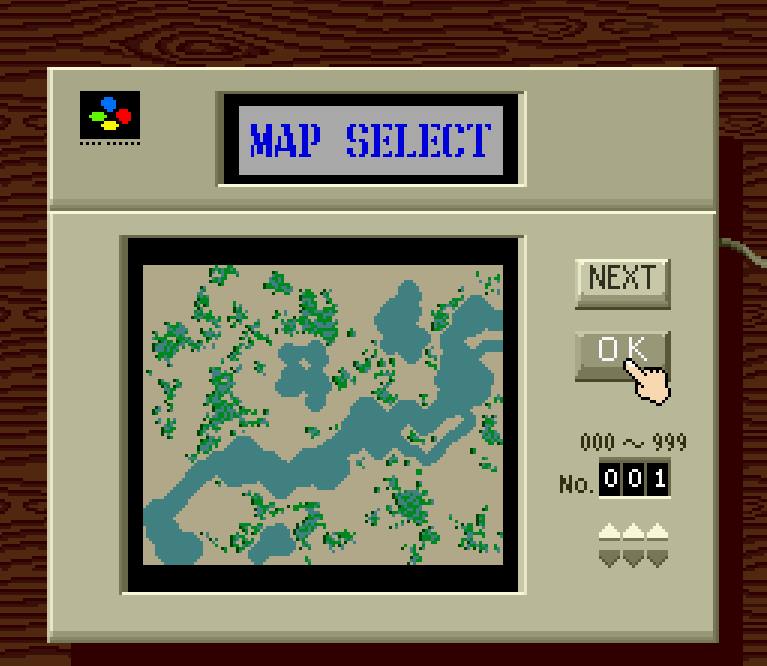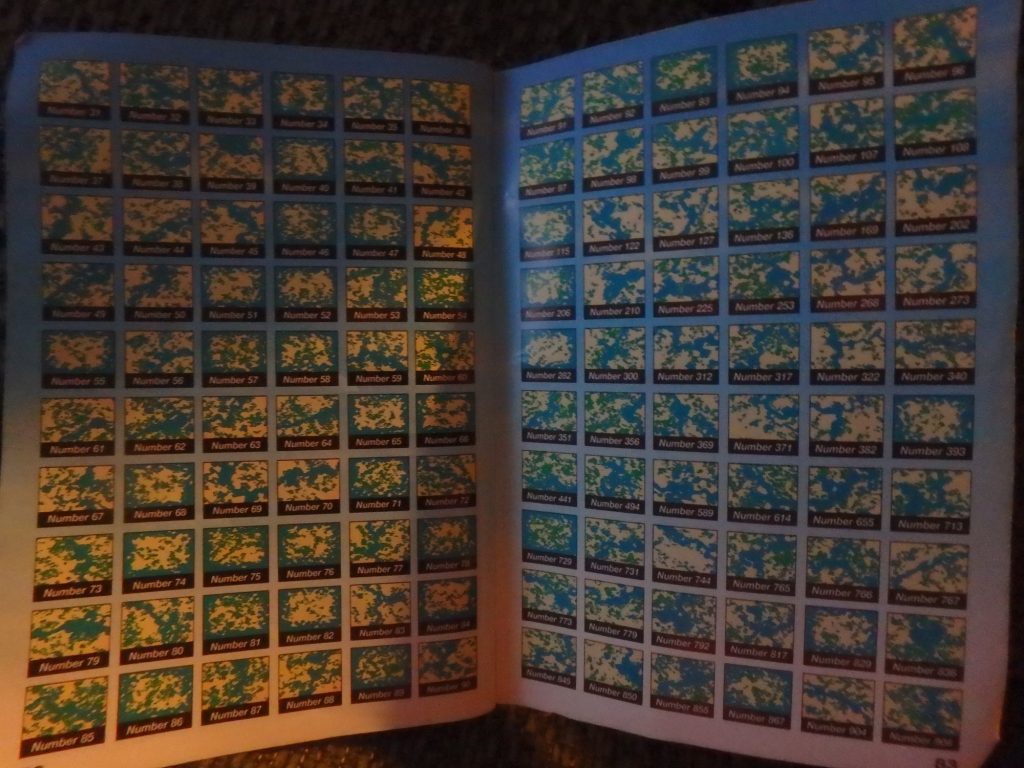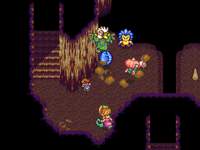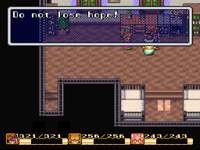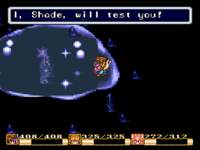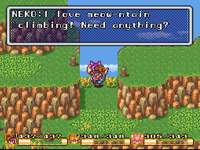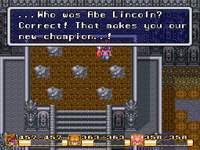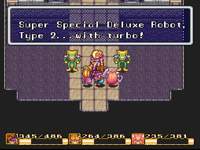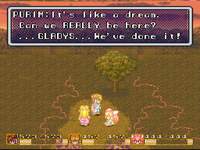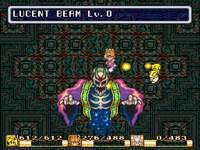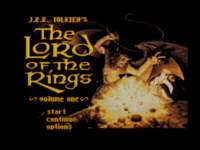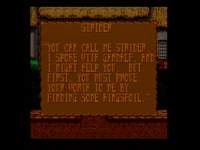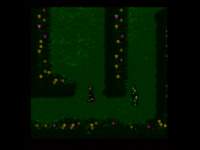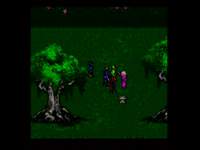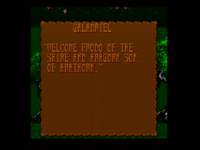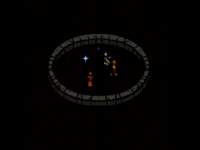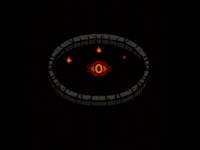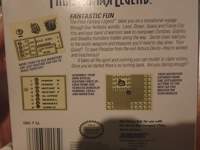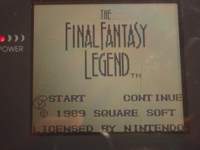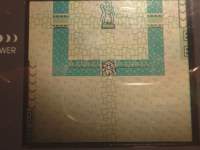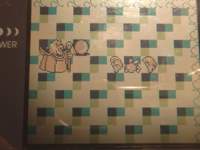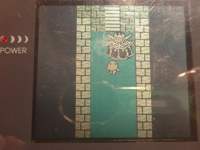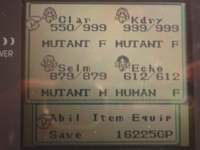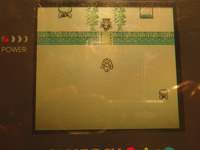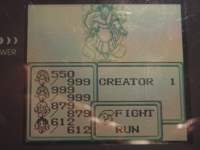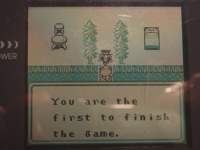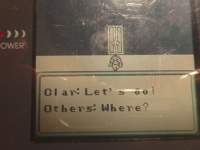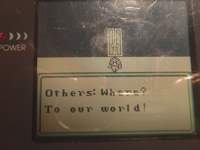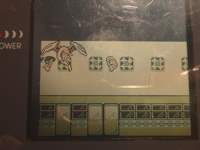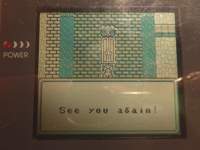The portraits you make on IR-7000 are not merely for spicing up your address book. They are integrated with a "game" and that game is called Brain Drain.
In Brain Drain you choose a portrait to play as, and face off against a different portrait using psychic abilities. It is a bit thin on gameplay and soundtrack but it is kind of fun.
Eons ago I wanted to see if the outcomes of the game were pre-determined based on the character features or if there is some RNG. So I cloned one character to see. It turns out, there is some RNG.
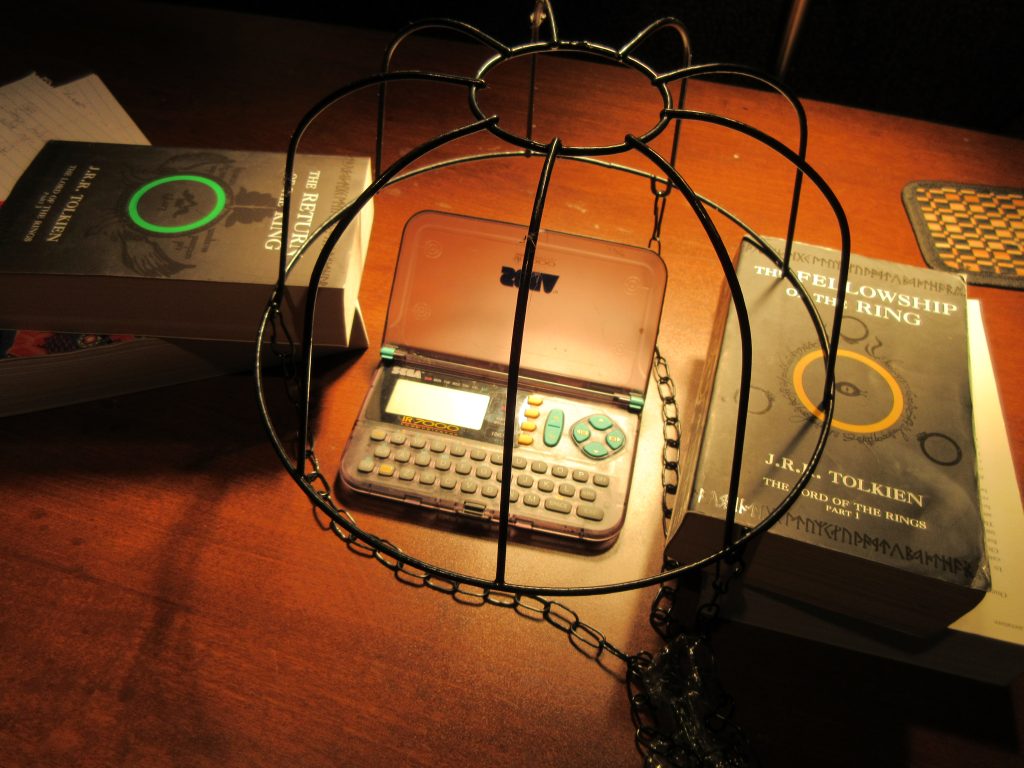
The mid-late 90s personal organizer. The big companies making them were Sharp and Casio, although there were a lot of other ones.
I still have mine, the IR-7000, made by Sega. Looks like this:
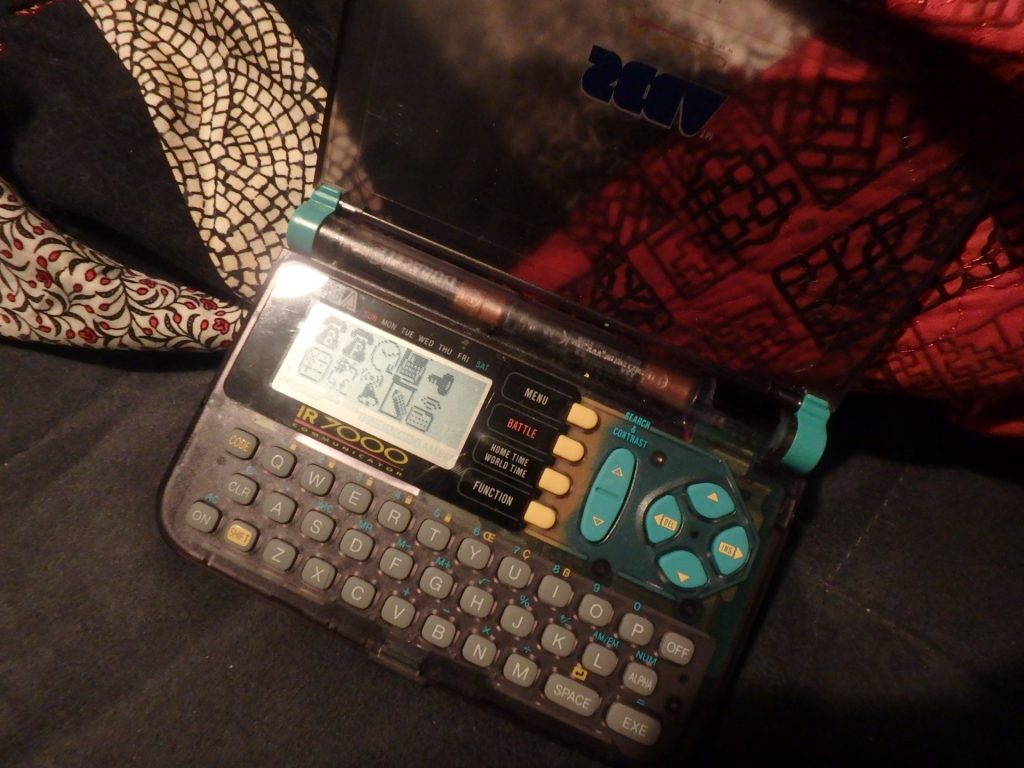
Still works turns out.
Like the standard organizer it flipped open and had a QWERTY keyboard. It could store notes, addresses, do calculator functions, time zone calculations, set an alarm and show you a calendar. Plus, a hilarious "human portrait" maker along with a simple game you can play with the portraits.
If two people had IR-7000, you could use its infra-red communication to exchange messages, but I never came across someone who also had this organizer. The industry was really fragmented toward lots of different organizers and everyone seemed to have a different one.
The modern equivalent today would be something between a cellphone or tablet. Cellphone and tablet subsume all of the functionality that these organizers had, but in much more general-purpose ways with fuller software stacks. I can understand why these fuller software stacks are desirable yet in my heart I'm always keeping a space for the long battery life and reliability of this specialized tool for specific things.
A response to this: "What were the five most important video games to you throughout your youth/teen years? No curating to look cool/interesting please"
1. Lagoon (SNES)
Comment: The first RPG I played. The environments and sense of world-building were a lot deeper than the other games I was familiar with, so it was easy to get really invested. The ultra-small hitboxes and the lack of user-friendliness I wrote off as "the game is hard" not "the game is flawed", so I spent effort getting better at the action mechanic. Nowadays the time I spend on Lagoon is part nostalgia, part meme-ery. It affected the ways I perceive other games then and today and led into ARPGs like Souls.
I've been maintaining a fan site for Lagoon for 13 years.
2. Speedway Classic (Apple II)
Comment: The game had this really cool looking 3D effect and a memorable intro. It was my go-to game on this platform narrowly beating out Lemonade Stand. Since I coded on this platform it was helpful to see the connection from code --> possible program.
3. Final Fantasy 3 or 6 (SNES)
Comment: This is a very normie pick. You know I'm taking the no-curating seriously.
This game for me is tied up with a) interest in video game characters, since before that I didn't play many heavily character-based games) first experiences in PC usage when trying to get more content for it.
I first played it around 1995 and wanted more content about it (besides a magazine article) but it was hard to find any. I didn't have a lot of experience using PCs or the internet but it was worth a try.
The best time was when my parents took me to a computer exhibit at the <city name> Science Center, they had a bunch of computers hooked up with internet access. It was a bit rough at the start because it was not like the Apple IIc (at home) or the IIe (at school) and the GUI/mouse/internet browser was a lot different, from what I recall the demo machines were Windows 95 with Netscape Navigator. But I got to use it to find a lot of cool things- secrets, strategies and so on.
4. Dynasty Warriors 4 (PS2)
Comment: This was when I was a teenager. Since I was under a lot of stress in high school, overbooked with way too many clubs + part time job, it was a good de-stresser.
5. Tekken 2 (Arcade)
Comment: Noise, dirty floors, cigarette smoke, frantically pushing the button + kicking the machine to un-jam your quarter. There were a couple dive-y arcades I used to go to. I used to always play as Angel on 2, Yoshimitsu on others, and got decent at those but didn't know any other moveset. Nowadays I can do some combos with Paul.
Honorable mention: Fatty Bear's Birthday Surprise, a point-and-click game for kids. The game is just so weird yet full of cool things. First seen at my daycare. I later got the CD from somewhere when I was in high school because I was nostalgic then too.


They are so uncommon let's take a second to appreciate SNES games with functional loading screens.
Game: Civilization 1
Loading time: ~40 seconds
Purpose: When you create a new game. It is procedurally generating the terrain of the map, placing the other civilizations you're playing with. Rather than a fixed map, it gets randomly generated each time plus the algorithm is customizeable to include different kinds of climates and features. The longest load time I have seen on this platform.
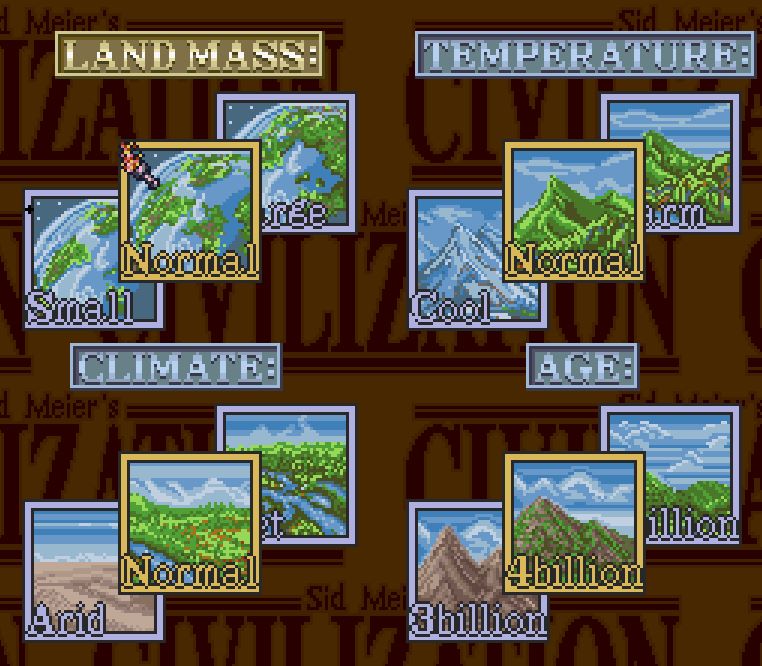
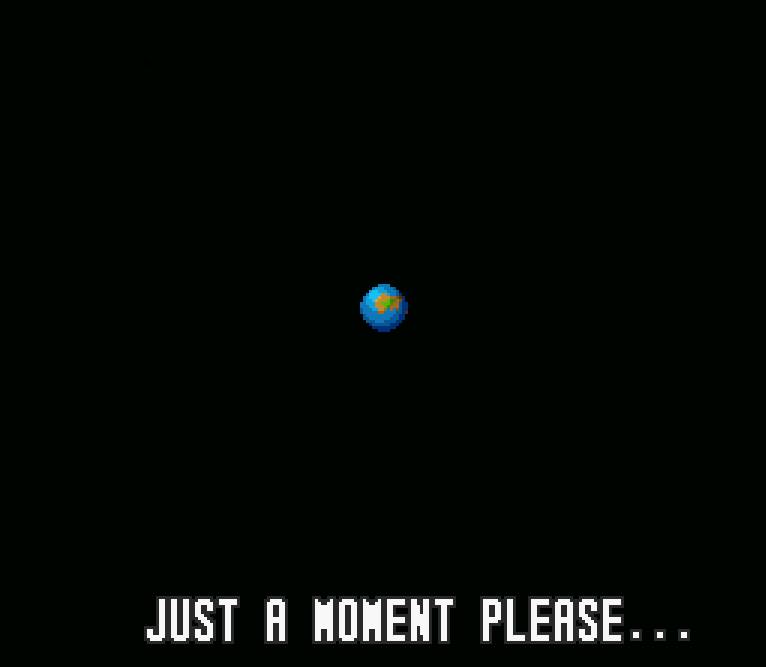
A video: https://youtu.be/oWtVe2qm7_w?t=129 (not mine, random search off youtube)
Game: Romance of the Three Kingdoms IV: Wall of Fire
Loading time: 2 or 3 seconds
Purpose: When you create a new game. Procedurally generating what commander has what resource allocations, which officers are where. Although the game comes with a fixed set of "scenarios", you can create your own commander and/or officers and choose who to control. I believe this, plus the difficulty level affects where the game places things and there are too many combinations to pre-compute them.
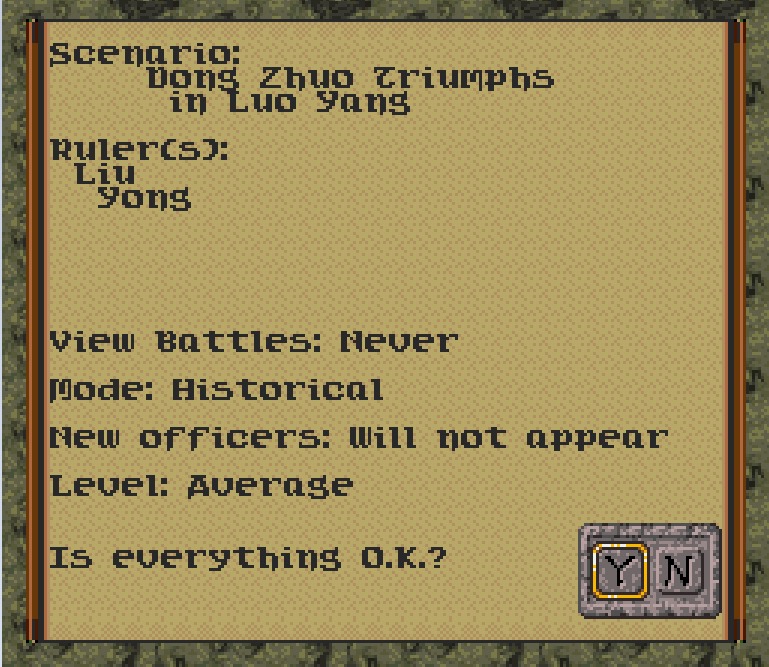
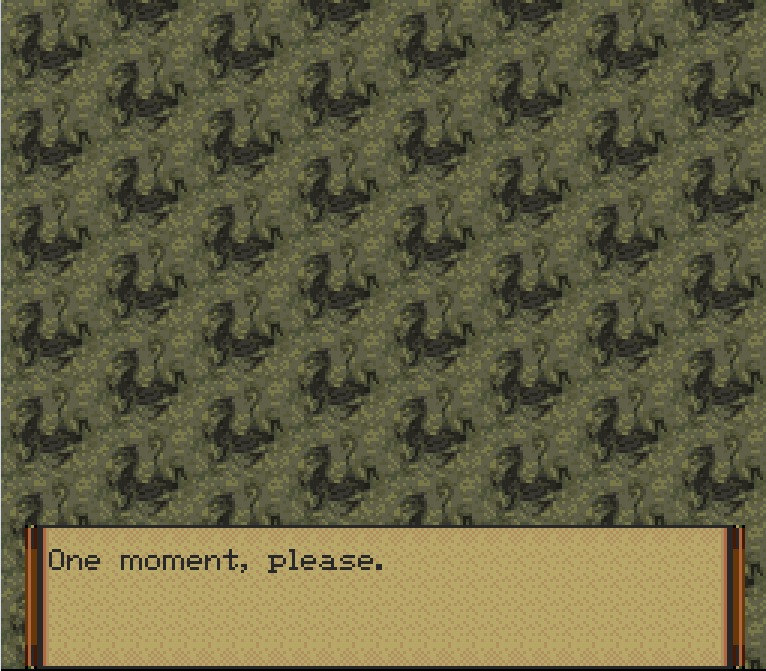
Game: Another World (also called, Out of this World)
Loading time: ~10 seconds
Purpose: Transitioning out of a simple menu, into the game
This game is, in a word, ambitious. Big, lush backgrounds with lots of things animating. Nothing looks like 'sprites'; they look like 2D vector graphics rasterized to low resolution to be honest.
This game was originally for Amiga and ported to SNES. The graphics have a unique style which unfortunately doesn't fit well to SNES technical constraints, which tend to involve either conventional 2D graphics modes with heavily re-used sprites, or just Mode 7-- neither of which fit this game well. Now that's not to say it can't work. Take, for example, the backgrounds of Super Mario RPG or Wonder Project J. You can make smart judgments about when to re-use sprites and try to hide them among the other elements. Of course, those games were designed from the ground-up for SNES. For this game, conversion to sprites would be an after-thought with the port. The sheer amount of graphics this game has is very large and scenes are organized in ways that are hard to break down into patterned elements.
While I don't tend to like this type of game- the latency of controls is so slow and loose, for one-- I respect its commitment to the unique art style. Given everything this game has going on, the loading screen is not frivolous.
Game: Sim City
Loading time: ~12 seconds
Purpose: When previewing the terrain on which to build your city- there are 1000 terrains (e.g., random seeds). Note that the load time is NOT just for creating a game with the level- it's to let you view a small 120x100 image. This, plus the instantaneous "OK" button tells us two things. First, there was not enough space on the cart to store 1000 of these images. Second, unpacking the preview image is about the same as unpacking the full map. While I think all of this is okay, they could have done with fewer better-optimized seeds. Fortunately the instruction manual has a couple pages of previews of maps which you can flip through quickly.
Game: Batman Forever
Loading time: ~5 seconds
Purpose: Transitioning out of cutscene into gameplay. Likely to be graphics-related. There are big, detailed sprites with lots of frames of animation.
Although there's an explanation for a load screen, it may not have been completely necessary. At 24Mbit, the cart is not that small; it's very likely the graphics could fit without super aggressive compression schemes. Some contributing factors to the need for load time may have been 1) the fact that this game is a port, and there wasn't time to optimize for any particular platform, and 2) these flashy 3D wireframe-map montage scenes, which would require different types of data and loader code.
Although this game gets a bad rap I respect its live-action-to-low-res-low-color Mortal Kombat aesthetic.
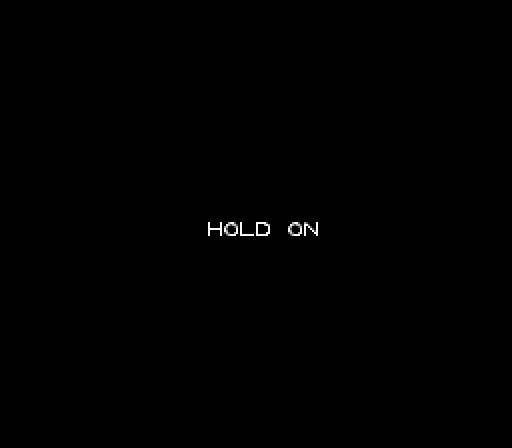

Maybe others I haven't encountered yet.
See, a couple big things affecting our modern conception of loading screens are optical media and network latency's failure to keep up with increasing size of game payloads. Computationally, modern computers have advanced a lot to the point where it is rare to see games spinning on procedural content like this, but it is common to spend a lot of time copying game assets from an optical medium to faster local solid-state storage, or downloading game assets from the internet.
There have been some modern efforts to curb load times. For example the Nintendo Switch had a return to a faster-than-optical-disk game media. You know, a cartridge. However, many Nintendo Switch games- non-procedural, fixed-level action games do have loading screens- screens which would have been unacceptable in 1995 but are acceptable now since we are used to them.
Earth, who wore it better?
left: E. V. O. (SNES) right: Civilization (SNES)

Finished Donkey Kong Country 2: Diddy's Kong Quest. This was a co-operative gameplay I finished with a couple friends as a follow up to our completion of Donkey Kong Country 1.
Completion time: about a year, since we played in small increments once in a while.
Game is longer and a lot spicier than 1. Some levels gave us a very hard time. Yeah I am a big fan of the minecart autoscroller.
Time and time again I am really impressed by how much graphics can be fit on a SNES cart. The levels are all full of lush, irregularly-shaped (non-tiled-looking) elements without a lot of repetition; sprites are big with lots of animations, lots of frames in each one; backgrounds have a lot of variety. At the same time, it also doesn't appear they got too fancy with storage of graphics. I looked at the ROM and could spot at least some 4bpp graphics data stored plain, uncompressed. They just used a big cartridge-- 32mb, big for this console.
The technical high points for this game are offline rather than online of course. These are pre-rendered 3D models rendered with Silicon Graphics software, likely on CPU, baked into a bunch of 2D sprites. Everyone likes this. I can't think of a single fourth-console-generation game which does this and looks bad. More games would have surely done it if it wasn't so expensive back then, in terms of money.
Only criticism is I was disappointed with the final boss fight. The fight from DKC1 established a pretty high bar, to be fair- it had that cool "fake credits then surprise there's more". Not saying DKC2 had to replicate that, but maybe the final boss could have had something else cool. Nope. You fight King K Rool on a pirate ship. He throws projectiles. Pretty standard stuff. Maybe they thought no one would get far enough to see that, due to Windy H̶e̶l̶l̶ Well.
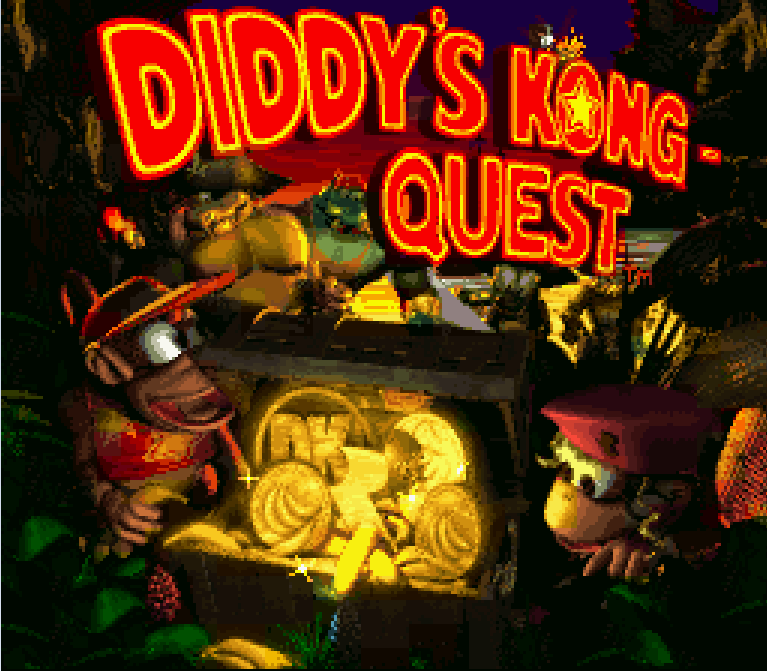
Total play time = 2 years, 156 days, 20 hours, 36 minutes, 39 seconds
Couple friends and I started playing back in April 2017. The progress isn't deliberately slow, it's just that we playing a half-hour or an hour here and there, once in a while and it's a proper full-length RPG. Furthermore we made a best effort to play it spoiler-free with as minimal outside help as possible.
I never beat this game before. SoM is in the category of "played as a child by repeated rental, wanted to own, couldn't get a copy".
It is hard nowadays imagining "not being able to purchase something" but was the situation here. If no video or toy store in our city had it then out of luck. There were also toy catalogs where you can phone or mail in an order, but they weren't a whole lot better in terms of the video game selection. The one place I could find that had Secret of Mana had it for rent. So I rented it repeatedly. I still had to take it back at certain intervals and some jerkface wiped my save. After that I became demoralized and moved on to playing something else (Uncharted Waters 2)
Fast-forward to today and I have every game in the world. This one has a lot of critical acclaim, and still has some love today (it got a remake last year), it deserves playthough to the end.
Originally I thought I'd move onto the remake after finishing this, but after reading some reviews, maybe not 🙁 It's just as well, initially I was kind of turned off by the graphics. When early gameplay came out I recall telling people it looked Bad. Like some free-to-play MMO from ~2006. It reminded me of Audition Online. I don't know what's up with the art direction. Apparently there are problems with the soundtrack and gameplay also... How did they mess this up? I may someday play it anyway but give it a while.
This game had a lot of positive qualities, it deserves to be on all those top-10 lists.
- The soundtrack is very strong
- Large sprites with nice animations
- Many cool concepts for bosses, large enemy artworks
- Willingness to make a three-player SNES game represents a lot of technical initiative
The one thing that was almost a problem- it is borderline on the "turn based games disguised as action games" genre.
You know. Practically very MMORPG does this. The combat works like: you and the enemy can both be freely positioned in the world, and can attach each other, but the attacks always land regardless of how you are positioned. Why have the positioning mechanic at all, then? Why not just have a menu? If they shoot an arrow or something it's not like you can move out of the way. I know why they do it in MMOs, but I'm less on board in any locally-played action game.
I suppose this bothers me because it encourages you to waste brain cells in combat trying to move around the map when you might as well just stand there.
Fortunately, this game doesn't 100% do that, it's only for certain attacks. Some experimenting helped figure this out. For other ones, you can move out of the way, sometimes outside of a hitbox that seems rather big.
On a whole I loved playing this game, and getting the chance to play it co-operatively even though it's long after the fact.
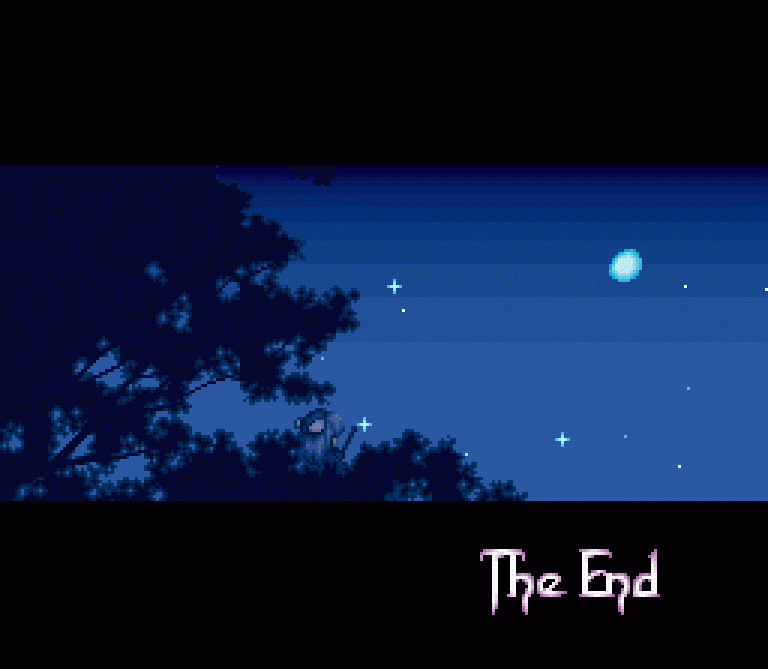
Finished J.R.R. Tolkien's Lord of the Rings (SNES)
This is an action-RPG based on the book series, pre-Peter Jackson movie IP.
This game has some cool moments and good atmosphere and potential to be good. Still, it was held back by many technical problems. This game ended up being a rabbit hole into something else.
A couple weeks ago, I cleared the last boss, the Balrog using the full party (minus Gandalf, since having him in your party prevents you from beating the boss; also Boromir is E_NOTIMPL) and finished the game but didn't get such a good ending because Merry and Pippin died in the boss fight. They die really easily.
So last Saturday, I booted up the game with the intention to resume at the boss fight, attempt it again and keep them alive.
However the password I had written down was rejected by the game. I swear to goodness I wrote it down correctly. I went upstairs to my computer, reproduced the situation with an emulator. It turns out, the game will indeed give you invalid passwords and that's what happened here. So I went about trying to figure out how to "fix" my password.
The password system itself involves encoding a bunch of the game state in a certain way with a checksum. This game is a bit unusual in that there are no saves to the cartridge, it hashes together literally all the state into a 48-character-long password. It took a bit of effort, but I figured out how to derive the password. From there, how to un-glitch my password and preserve the progress I had (items, character stats, door open+close state) while letting it be accepted by the game. With this, I was able to re-attempt the boss fight and get the good ending!
After trying many different passwords looking for patterns, I cracked the password algorithm. It was not too much more work to put it into a program in case other people run into the same issues.
I posted the program to Github https://github.com/clandrew/lotrpwcheck/ .
As for the ending itself it was pretty cool, there is a scene where you meet Galadriel and she shows you the mirror. Although they never released a Vol II for SNES, I can see the next one picking up where this one left off.
This was after I tried
- Cleaning cartridge reader with rubbing alcohol
- Cleaning cartridge with rubbing alcohol
- Re-seating the 72 pin connector
- Replacing the 72 pin connector
I'm sad to say this console has never worked, this is just the last straw. I got it as-is at a garage sale >10 years ago. There are multiple problems. First was with what appears to be the PPU; the evidence is that a sprite layer is invisible. See how the placed pieces show up, but the piece-in-flight does not. And then there were problems with the 72-pin connector. Before re-seating, it was black screen. After re-seating, it showed the corrupted image.
It's tragic, the feature that makes me want the NES instead of an emulator (that tactile-ness of cart pushing in-and-down) is also one of the features that kills it.
I kept this console for parts, got a new one and it's working well.
Finished Final Fantasy Legend (GB)
This is a spin-off to the Final Fantasy series and related to the Sa-Ga series made by Square Enix.
The whole thing with Legend is it's "a lot more epic than it seems like it should be". See the games I remember Game Boy original were fairly light in subject matter, emotional power and how the story is delivered. But, this game:
• Levels with a scary unkillable monster
• Real actual character death
• An ending sequence where you fight the creator of the universe
Confirmed the creator of the universe is wearing a top hat
It turns out the composer for this game is also Nobuo Uematsu the same as mainline Final Fantasy series except for XIII. If you listen carefully you can hear similarities to the rest of the series' music.
For the gameplay, you have the flexibility of choosing all characters in your party and their type (Human, Mutant, Monster). The game suffers from some balancing issues which make certain bossfights far, far disproportionally harder than others.
There is apparently an homage to Legend in Final Fantasy XIII where (spoiler) Orphan can be killed instantly by Vanille's Death spell. It is not 100% guarantee but there is a chance particularly if staggered. In the Final Fantasy XIII Scenario Ultimania book it says outright this was an intentional reference to Legend.
